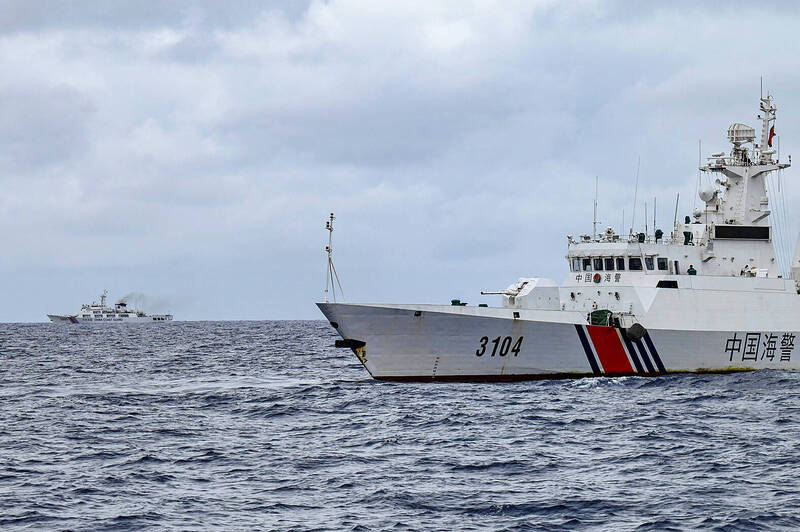《TAIPEI TIMES》 Beijing’s Strait expansion facing pushback: bureau

China Coast Guard ships are pictured from the Philippine Coast Guard vessel BRP Cabra during a supply mission to Sabina Shoal (Xianbin) in disputed waters of the South China Sea on Aug. 26. Photo: AFP
CONCERNED: The US, its allies and European countries are highlighting peace in the Taiwan Strait, as China continues to enter other countries’ restricted waters and airspace
By Wu Che-yu and Lery Hiciano / Staff reporter, with staff writer
China’s attempts at expanding into waters around Taiwan are facing international pushback, the National Security Bureau (NSB) said.
Beijing’s expansion into the Taiwan Strait, and East China and South China seas has triggered international countermeasures, the NSB said in a report to the Legislative Yuan.
The US and China have not changed their strategic rivalry, it said. The US is closely monitoring China’s coercive “gray zone” tactics in the Indo-Pacific region and expressed support for maintaining the “status quo” in the Taiwan Strait. Meanwhile, China maintains its position on Taiwan, emphasizing its right to enforce its laws in the South China Sea, and has attempted to exclude the US in the ongoing issue according to the Declaration on the Conduct of Parties in the South China Sea agreement.
As a way to counter the US’ containment strategy, China has also suspended arms control and arms proliferation consultations with the US, the NSB added.
Chinese President Xi Jinping (習近平) has tried to prepare his party and armed forces for military conflict at sea, and promote the construction of “modern” sea and air border defenses, the report said.
China has also expanded its jurisdiction in the region through laws such as China Coast Guard Regulation No. 3, which allows the coast guard to board and hold vessels in disputed waters it claims, as well as augmenting its patrols and surveillance at sea, the NSB said.
In the area around the Taiwan Strait, the Chinese People’s Liberation Army (PLA) has renovated coastal airports and used military exercises to demonstrate the integration of its maritime policing and military capabilities and put pressure on Taiwan, it said.
The PLA has frequently crossed into the restricted waters around Taiwan’s outlying islands with military, non-military and dual-use vessels, and has even sent small speedboats to Linkou (林口) and Tamsui (淡水), expanding the potential area of “gray zone” tactics and further harassing Taiwan, the report said.
In the East China Sea, the PLA recently sent four armed vessels to the Diaoyutai Islands (釣魚台) — also known as the Senkakus in Japan — in addition to its patrols around Japan’s Ryukyu Islands and sending an intelligence-gathering plane in Japan’s airspace for the first time in August, it said.
In the South China Sea, the PLA held joint naval exercises with the Russian navy for the first time in eight years and has made controversial actions such as ramming Philippine Coast Guard vessels, it added.
In response, the US and its allies have frequently highlighted the importance of peace and stability in the Taiwan Strait and have opposed China’s provocations, the report said.
The US has made Japan the centerpiece of its Indo-Pacific strategy through the recently upgraded US unified command in Japan, its attempts to bring Japan closer to the Philippines and Australia, the AUKUS security alliance and the Quad — consisting of Australia, Japan, India and the US, the NSB said.
European countries are also increasingly expressing their concerns about the stability and peace in the region by making more frequent transits through the Taiwan Strait and their participation in joint military training exercises, it added.
新聞來源:TAIPEI TIMES















